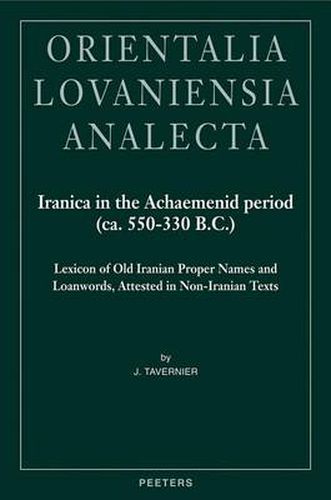Readings Newsletter
Become a Readings Member to make your shopping experience even easier.
Sign in or sign up for free!
You’re not far away from qualifying for FREE standard shipping within Australia
You’ve qualified for FREE standard shipping within Australia
The cart is loading…






This book collects and discusses the Old Iranian divine names, personal names, geographical names (toponyms, hydronyms and oronyms) and loanwords, which are attested in texts written in Aramaic, Babylonian, Egyptian, Elamite, Lycian, Lydian and Phrygian. The texts, both royal inscriptions and documentary texts, are discovered in the entire territory of the Achaemenid Empire (from Egypt to Bactria), which controlled the Ancient Near East from ca. 550 to 331 B.C. The Iranica discussed in this book are divided into four categories: (1) directly transmitted Iranica, (2) semi-directly transmitted Iranica, (3) foreign Iranica and (4) indirectly transmitted Iranica (the so-called Altiranische Nebenuberlieferung ). All expressions, which do not belong to one of these categories, are brought together in a section called Incerta . The etymology and linguistic setting of each Iranian expression is studied and a list of occurrences is added to this analysis.
$9.00 standard shipping within Australia
FREE standard shipping within Australia for orders over $100.00
Express & International shipping calculated at checkout
Stock availability can be subject to change without notice. We recommend calling the shop or contacting our online team to check availability of low stock items. Please see our Shopping Online page for more details.
This book collects and discusses the Old Iranian divine names, personal names, geographical names (toponyms, hydronyms and oronyms) and loanwords, which are attested in texts written in Aramaic, Babylonian, Egyptian, Elamite, Lycian, Lydian and Phrygian. The texts, both royal inscriptions and documentary texts, are discovered in the entire territory of the Achaemenid Empire (from Egypt to Bactria), which controlled the Ancient Near East from ca. 550 to 331 B.C. The Iranica discussed in this book are divided into four categories: (1) directly transmitted Iranica, (2) semi-directly transmitted Iranica, (3) foreign Iranica and (4) indirectly transmitted Iranica (the so-called Altiranische Nebenuberlieferung ). All expressions, which do not belong to one of these categories, are brought together in a section called Incerta . The etymology and linguistic setting of each Iranian expression is studied and a list of occurrences is added to this analysis.